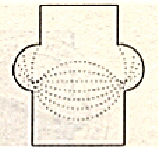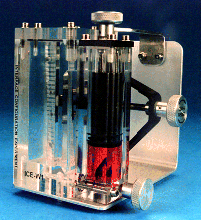
The following summarizes the Interface Configuration Experiment, part of the Glovebox project in the first and second United States Microgravity Laboratory (USML-2), part of a NASA Columbia shuttle mission, October 20-November 5, 1995. Paul Concus of the University of California at Berkeley was the principal investigator for the Interface Configuration Experiment, collaborating with Robert Finn of Stanford University and Mark Weislogel of NASA Lewis Research Center. Since then, further shuttle experiments have been conducted to test the theory. See http://spaceflight.nasa.gov/history/shuttle-mir/science/mg/sc-mg-ice.htm. This summary was taken from the Interface Configuration Experiment homepage, which is no longer accessible.
When planning space-based operations, it is essential to be able to predict the locations and configurations that fluids will assume in containers under low-gravity conditions. For example, one would be in serious difficulty if one did not know in advance where the fuel is to be found in a fuel tank. Predictions using currently available mathematical theory extend, however, only to a few simply containers, such as the right circular cylinder and the sphere. Even for these geometries, the present theory is inadequate for dealing with such unaccustomed liquid configurations as a column or bridge extending across the interior of the container, a situation that can be expected to occur under reduced gravity.
| The classical theory, according to the Young-Laplace-Gauss formulation, characterizes fluid locations as local minima of the surface-plus-gravitational mechanical energy. Using this point of view in a mathematical study, Concus and Finn have calculated the shapes of axially symmetric "exotic" containers with the remarkable property that for given contact angle and fluid volume, an infinity (in fact, an entire continuum) of distinct symmetric equilibrium configurations can appear, all of which have the same energy . These equilibrium configurations turn out to be unstable, and it can be shown that particular asymmetric deformations yield configurations with lower energy. By a careful construct, it was possible to demonstrate a symmetric container that admits infinitely many symmetric equilibrium interfaces, but for which no interfact that mimizes energy can be symmetric. This is in notable contrast with what happens in the familiar case of the right circular cylinder, for which the symmetric interface is stable, and no asymmetric ones can appear. |  |
There is no known way to predict theoretically what surfaces will actually mimimize energy, although numerical computations suggest that at least three (asymmetric) local minima must be reckoned with. Also it is not clear to what extent the idealizations of the formal theory will be reflected in reality. Thus it is of great interest to determine experimentally what energy-mimimizing configurations there might be for the exotic containers, both as an indication of the limitations of classical theory and as a guide to future theoretical study.
 |
The containers for the experiment resemble a right
circular cylinder with a toroidal-like bulge at its
midpoint. Such containers were designed and tested at the
NASA Lewis Research Center Zero Gravity Facility by
Weislogel. Information obtainable from the tests is
necessarily incomplete because of the limited low-gravity
time afforded by the drop tower, which is generally
insufficient for equilibrium to be reached. This
situation is impaired further by unwanted surface waves
produced by the initial change in gravitational
environment. Nevertheless, asymmetric configurations were
observed for some cases, as predicted by the mathematical
results. More detailed and extensive tests in space are
expected to give a clearer view as to the significance of
the findings and to yield information on the effects
associated with contact-line resistance (contact-angle
hysteresis), accuracy of the machined vessel,
inaccuracies in measured equilibrium contact angle, and
other effects not included in the classical theory. This summary was taken from the Interface Configuration Experiment homepage (no longer accessible). |
For an excellent overview , see the featured article in the AMS Notices August 1999 issue, Capillary Surface Interfaces by Robert Finn. This article includes history of this mathematical problem, current theory, and experimental results from both NASA shuttle missions and Mir space station experiments.
Among many papers by Robert Finn and coauthors is one written
with me while I was an undergraduate at Stanford:
Robert Finn and Tanya Leise, On the canonical
proboscis, Zeit. Anal. Anwend, 13 (1994) no. 3,
443-462. Abstract: We examine a "canonical
proboscis" cross-section of a capillary tube as the basis of
a method for measuring the contact angle between a solid and a
liquid in microgravity. The canonical proboscis domains
corresponding to a prescribed contact angle g0 are critical
for the domain and angle, in the senses that (i) a solution of
the capillary problem for angle g in the absence of gravity
exists over the domain if and only if g is closer to p /2 than is g0, and
(ii) singular behavior at g = g0 occurs precisely over the proboscis portion of the
domain.
See also Robert Finn's book Equilibrium Capillary Surfaces, published by Springer-Verlag, 1984.
Back to Research and Projects